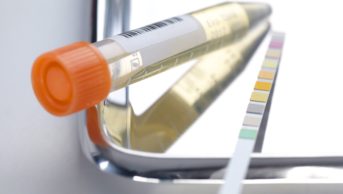
Wes Mountain/The Pharmaceutical Journal
By the end of this article, you will be able to:
- Understand the role of fast and slow thinking during diagnostic reasoning;
- Know how to structure your diagnostic approach;
- Use illness scripts as a tool for developing your diagnostic efficiency.

RPS Competency Framework for All Prescribers
This article aims to support the development of knowledge and skills related to the following competencies:
Domain 1: Assess the patient (1.6, 1.7, 1.8, 1.10, 1.11, 1.12)
- Takes and documents an appropriate medical, psychological, and medical history including allergies and intolerances;
- Undertakes and documents an appropriate clinical assessment;
- Identifies and addresses potential vulnerabilities that may be causing the patient/carer to seek treatment;
- Requests and interprets relevant investigations necessary to inform treatment options;
- Makes, confirms or understands, and documents the working or final diagnosis by systematically considering the various possibilities (differential diagnosis);
- Understands the condition(s) being treated, their natural progression, and how to assess their severity, deterioration and anticipated response to treatment.
Introduction
Diagnostic reasoning is a concept often used interchangeably with terms such as ‘clinical reasoning’, ‘clinical problem solving’ and ‘clinical decision making’. Collectively, it is recognised that these terms are representing the central idea proposed by Barrows and Tamblyn of describing the “cognitive process necessary to evaluate and manage a patient’s medical problem”[1,2]. A broader definition encompasses the idea that diagnostic reasoning is the conscious and unconscious interpretation of patient data, and the consideration of risks and benefits of actions to determine a working diagnosis and treatment plan[3].
Historically, diagnostic reasoning has focused on the process of applying the information you have gained from your history taking and physical examinations to formulate your list of potential causes for the patient’s presenting complaint and creating your differential diagnosis[4]. When considering the changing role of pharmacists as independent prescribers, it can also involve the process of identifying medication-related problems, considering therapeutic options and optimizing medication regimens[5,6].
It is recommended that you read this article in conjunction with these resources from The Pharmaceutical Journal:
- ‘Introduction to the prescribing consultation‘;
- ‘Principles of effective history taking when prescribing‘;
- ‘Introduction to clinical assessment for prescribers‘;
- ‘Performing a physical examination on a patient when prescribing‘.
To help further expand your prescribing skills, additional related articles are linked throughout. You will also be able to test your knowledge by completing a short quiz at the end of the article.
Structuring diagnostic reasoning
A commonly accepted theory of diagnostic reasoning was proposed by Kahneman who describes the two different thought processes that occur when making a decision; this dual processing involves system 1 and system 2 thinking. It is acknowledged that clinicians interchange and combine their diagnostic reasoning method depending on the scenario and their own experience[7].
System 1 and system 2 thinking
System 1 — intuitive system: the fast, automatic reaction to information based on mental shortcuts formed from patterns or habits. This is often triggered when dealing with common, typical, and uncomplicated presentations.
System 2 — hypotheticodeductive system: the slow, systematic, controlled process based on conscious judgement, logic and the range of probabilities being considered. This is often triggered if the presentation is not recognised, atypical or ambiguous.
Watch this short video for more commentary on system 1 and 2 thinking applied in a clinical context.
Effective diagnostic reasoning often utilises both system 1 and system 2 thinking and requires a combination of experience and skills (pattern recognition, critical thinking, communication skills, evidence-based practice, teamwork and reflection)[8]. The reasoning process needs to be considered as comprising four discrete stages: information gathering, hypothesis generation, hypothesis testing and reflection[9]. We will now briefly consider each.
1. Information gathering
The first step of diagnostic reasoning is processing the information that can be gained from the patient’s health record, history, laboratory results, tests, and physical examination. For example, recent medication changes, blood pressure readings, creatinine clearance trends and physical features following examination (e.g. ankle swelling, shortness of breath).
2. Hypothesis generation
From here it becomes possible to also generate a broad, if not exhaustive, list of possible conditions that could be considered at this stage of the process[10]. When there are many signs and symptoms to consider, or a vague presentation, it can be challenging to match the information gathered with a single problem or even a problem shortlist. At this stage, a system 2 approach can be adopted where clusters of observations are separated and explored systematically within themes (e.g. anatomical location, the patient’s age, timing or onset of symptoms, review of body systems or multisystem conditions). Some examples of the benefits to this approach are shown in the Table.
3. Hypothesis testing
By now, the problem list has been reviewed, rationalised and prioritised to generate the working hypothesis (or differential/working diagnosis), through a focused matching of the symptoms to possible diseases or medication-related issues and cross-matching back the associated symptoms with the patient’s presentation and medication history.
This step promotes the identification of defining features of a condition, or where they exist, discriminatory features that are unique for a particular disease[10]. This process will allow the elimination of conditions that do not match and rationalises your list of differentials to a more specific list of possibilities[4]. For example, shortness of breath and coughing without signs of infection may rule out community acquired pneumonia; coughing up pink sputum may point towards pulmonary oedema.
Finally, further investigations to either provide pertinent negatives or confirmatory findings should be considered. For example, a patient may present with symptoms of heart failure following a recent myocardial infarction (e.g. shortness of breath, oedema) and has a raised B-type natriuretic peptide (BNP), but would require an echocardiogram to confirm diagnosis.
This working diagnosis then informs the treatment plan.
Throughout this whole process it is essential that you are vigilant to potential life-limiting conditions, including how to identify or rule out red flags and when onward referral will be required[4,11]. At all times it is imperative that you work within your scope of practice and have the requisite self-awareness to know when to refer to a more senior clinician, or involve another healthcare professional in your decision-making process.
4. Reflection
For all prescribers, but particularly those early in their career or working in a new scope of practice, an organised approach is critical to avoiding cognitive errors when generating the hypothesis of the diagnosis. Experience using system 1 thinking can allow pattern recognition to generate a diagnosis based on conditions, patients, and case reviews we have seen before and there is a risk that the prescriber may apply biases from their known experience rather than the full depth of information that has been presented. The application of a system 2 approaches offers a well-considered and more accurate diagnosis[11].
Having formulated a working diagnosis, it may sometimes be appropriate to perform further tests to confirm the diagnosis. In 2014, Kohn identified that three pertinent questions for diagnostic reasoning when considering if further tests are required[12]:
- How likely is the patient to have this disease?
- How good is this ‘test’ for the disease in question?
- Is the test worth performing to guide treatment?
Finally, the identified problem and the reasoning to support this should be succinctly documented in the patient record[12].
The illness script method
An alternative understanding and application of diagnostic reasoning is the use of ‘illness scripts’. This is where a clinician relies upon prior learning and their first-hand experiences to recognise a pattern of clinical characteristics as clues to the potential diagnosis. An illness script is a mental cue card that represents individual diseases, including their typical casual features, the actual pathology, the resulting signs, symptoms, expected diagnostic findings and the most likely course/prognosis with suitable management.
Illness scripts can help prescribers focus their questions during history taking, contextualise patterns of signs and symptoms and help to integrate new clinical knowledge with existing knowledge. A novice prescribing clinician will have limited experience to draw from initially so will rely upon their biomedical knowledge and have a broad range of differential options where symptoms may need to be worked through one by one. Experienced practitioners will have had time to hone their scripts so that they are quicker and can support a diagnosis more directly. Regardless of experience, the illness script requires knowledge of the epidemiological factors of the disease, the associated signs and symptoms and the pathophysiology. Some models of illness scripts also consider the time-course of the disease[10,13,14].
We can use an illness script approach for many conditions, and you may already have some well-developed scripts for conditions you commonly see in your own clinical practice. For example, an illness script for croup could involve the following: epidemiology (infants and toddlers), pathophysiology (parainfluenza virus), presentation (fever, barky cough, stridor, worse at night) and management (hydration, paracetamol).
The following case illustrates how an illness script can be developed and used to form a diagnosis.
Case in practice
 Patient profile: A 58-year-old male presents to you with a new onset pain in their left large toe joint. He tells you that he works in an office, drinks a few pints of beer most nights of the week, eats lots of fast food and does not take any regular exercise. You observed that he was walking with a limp, is moderately obese, but otherwise appears well. He tells you there was a slight pain yesterday, but the pain is worse this morning, the joint is hot to touch and is swollen.
Patient profile: A 58-year-old male presents to you with a new onset pain in their left large toe joint. He tells you that he works in an office, drinks a few pints of beer most nights of the week, eats lots of fast food and does not take any regular exercise. You observed that he was walking with a limp, is moderately obese, but otherwise appears well. He tells you there was a slight pain yesterday, but the pain is worse this morning, the joint is hot to touch and is swollen.
Action: List the questions that you would ask the patient, what physical examination could/would you undertake? What illness scripts did you form as you read through the case presentation? How can this inform the diagnosis?
Discussion: Several features of the presentation indicate that the patient has gout, rather a chronic condition such as arthritis, including:
- Presentation as an acute flare of symptoms;
- Onset of symptoms were abrupt;
- Pain is localised and severe;
- It is affecting a single joint.
The effectiveness of your script will have been influenced by how much you already knew about gout. Awareness of the epidemiology of the condition, the temporal pattern of symptom presentation and predisposing conditions, specifically any (single joint) or discriminating symptoms (episodic acute pain) will have helped you to reach a diagnosis directly. Novice practitioners whose illness script for gout is still forming may need to spend longer working through the information gathered before they can differentiate the patient’s disease from others that may have a similar presentation.
The script will have included ideas to eliminate other diagnostic possibilities and to weigh up the possibilities of the likely diagnoses. For example, you would have asked questions about acute trauma or injuries to exclude fractures and ruled out the unlikely condition of septic arthritis as the patient is not presenting with any systemic signs of infection.
For more information on gout, see: ‘Treatment and Management of gout: the role of pharmacy‘.
While learning to understand the processes of diagnostic reasoning, it is also important to recognise the potential sources of error, which may include[15]:
- Anchoring bias: the tendency to formulate and fix your idea early in the process and not adjust thinking if new information becomes available;
- Availability heuristic: Assuming a diagnosis because you have seen lots of recent cases;
- Confirmation bias: Seeking evidence to support your initial impression/diagnosis and ignoring information that does not support your diagnosis;
- Diagnostic momentum: Relying on previous clinicians’ diagnostic decisions and ignoring new information that may be contradictory;
- Framing effect: How the information is presented influences the diagnosis (e.g. emphasising or excluding certain clinical variables or elements such as CD4 count, abdominal pain weight loss, anxiety, polysubstance abuse can lead to different diagnostic considerations, ranging from viral gastroenteritis, hyperthyroidism, malnutrition or drug toxicity);
- Representation error: Not considering the prevalence for a condition when predicting the likelihood of the condition;
- Visceral bias: where either negative or positive feelings towards the patient influences your decisions and diagnosis.
Tips and guidance for good diagnostic reasoning
There are several things prescribers can do to help guard against these common sources of diagnostic error[16]:
- Slow down. Although time is often pressured there are also threats to sufficient information gathering and unconscious biases when you are rushing;
- Consider the likelihood of the presenting problems — “common things are common”. That being said, a broad awareness of some more rare diseases is required, as well as openness to consider them;
- Consider what information you have and focus on what is truly relevant;
- Actively consider alternative diagnoses. Pay specific attention to the potential for life limiting conditions and presenting symptoms. For example, it is important to rule out temporal arteritis in those presenting with headache if scalp tenderness is present;
- Ask active questions to rule out or disprove conditions that are part of your working diagnosis (distinguishing factors of those diseases). For example, chest pain that occurs only on inspiration compared to that occurring at rest may point to a respiratory rather than a cardiac cause;
- Consider the implications of a wrong diagnosis.
The principles of diagnostic reasoning are founded on the pharmacist undertaking effective continual professional development and practicing evidence-based diagnosis and medicine. Professional experience and exposure to different illnesses will grow naturally over time but it is important that prescribers continuously invest in developing their knowledge of the conditions being treated, their natural progression and how to assess their severity, deterioration and anticipated response to treatment.
The following scenario provides an opportunity to explore some of the concepts introduced in this article and apply them to practice.
Case in practice
 Patient profile: A 19-year-old female patient presents to you, stating they have been feeling exhausted for weeks, they have had difficulty sleeping for the past two nights owing to full body aches, localised pains, and feeling sweaty and cold.
Patient profile: A 19-year-old female patient presents to you, stating they have been feeling exhausted for weeks, they have had difficulty sleeping for the past two nights owing to full body aches, localised pains, and feeling sweaty and cold.
Your physical examination identified that the pharynx is inflamed, chest examination is clear and there is no impaired motion of any joints in the body. The laboratory results show a raised CRP, Hb 116g/L, raised white cell count, temperature 38.4oC.
Action: From the details provided here: write a list of your most likely differential diagnosis and any additional tests that you may request.
Using the cluster of observation approach (see Table), how could you reach a diagnosis for the differential list you have created?
Discussion (applying system 2 thinking): Taking the anatomic location approach, you start with the head and explore the history further to identify that the source of pain is in the throat and mostly on swallowing. Your physical observations match this, with pustular and inflamed appearance of the tonsils. The results of the rapid antigen test are positive.
Considering the age of the patient, the common differentials for the symptoms as identified for the location could include viral or bacterial sore throats, with the antigen test making bacterial infection most likely. The patient’s age indicates there is risk of glandular fever (mononucleosis) and understanding the onset of symptoms can be a useful determining factor here.
Linking the onset of the different signs and symptoms can help to differentiate the story and likely diagnosis. For this case, as the exhaustion predates the sore throat, this differentiates between the two most common concerns, which are glandular fever and streptococcus sore throat. In the absence of laboratory test results, this is a key component of the diagnostic reasoning that would support a diagnosis of bacterial sore throat. The exhaustion/lethargy in this case is unrelated to the sore throat and could be linked to other conditions or lifestyle. Conversely, had the sore throat persisted for weeks and then the lethargy started later, this would be more indicative of glandular fever.
This diagnosis can be corroborated by looking at the involvement of other body systems. The systems in this case are localised and the more general signs and symptoms of fever and aches can be linked back to your likely differential diagnosis. If other systems were involved, for example abdominal tenderness, this could influence your diagnostic reasoning and prompt you to further explore the potential diagnosis of glandular fever.
As the presenting patient was young and there was no recorded history of smoking or occupational hazards, there were numerous conditions that were not part of your initial differential list.
Reflections on the case: How would your diagnostic reasoning change if the patient presenting was a 59-year-old male with a 40-pack-year smoking history and recent unplanned weight loss?
How would your diagnostic reasoning change if the patient presenting was a 36-year female refugee living in shared accommodation?
For more information on assessment of sore throat and use of Centor and FEVERPAIN prediction tools, see:

Knowledge check

Expanding your scope of practice
The following resources expand on the information contained in this article:
- ‘How to use clinical reasoning in pharmacy‘, The Pharmaceutical Journal;
- ‘Effective practitioner: core skills of decision making‘, NHS Education Scotland;
- ‘How to apply evidence to practice‘, The Pharmaceutical Journal.
- 1Barrows HS, Tamblyn RM. Problem-based learning: an approach to medical education . New York: Springer 1980. https://app.nova.edu/toolbox/instructionalproducts/edd8124/fall11/1980-BarrowsTamblyn-PBL.pdf (accessed February 2024)
- 2Round A. Introduction to clinical reasoning. Evaluation Clinical Practice. 2001;7:109–17. https://doi.org/10.1046/j.1365-2753.2001.00252.x
- 3Dy-Boarman EA, Bryant GA, Herring MS. Faculty preceptors’ strategies for teaching clinical reasoning skills in the advanced pharmacy practice experience setting. Currents in Pharmacy Teaching and Learning. 2021;13:623–7. https://doi.org/10.1016/j.cptl.2021.01.023
- 4Bickley L, Szilagyi P, Hoffman R, et al. Bates’ guide to physical examination and history taking. 13th ed. Philadelphia: Wolters Kluwer; 2021.
- 5Wright DFB, Anakin MG, Duffull SB. Clinical decision-making: An essential skill for 21st century pharmacy practice. Research in Social and Administrative Pharmacy. 2019;15:600–6. https://doi.org/10.1016/j.sapharm.2018.08.001
- 6Eva KW. What every teacher needs to know about clinical reasoning. Med Educ. 2005;39:98–106. https://doi.org/10.1111/j.1365-2929.2004.01972.x
- 7Kahneman D. Thinking fast and slow. 1st ed. New York: Farrar, Straus and Giroux 2011.
- 8Effective Practitioner. Core skills of decision making. NHS Education for Scotland. https://www.effectivepractitioner.nes.scot.nhs.uk/clinical-practice/core-skills-of-decision-making.aspx (accessed February 2024)
- 9Trimble M, Hamilton P. The thinking doctor: clinical decision making in contemporary medicine. Clin Med. 2016;16:343–6. https://doi.org/10.7861/clinmedicine.16-4-343
- 10Bowen JL. Educational Strategies to Promote Clinical Diagnostic Reasoning. N Engl J Med. 2006;355:2217–25. https://doi.org/10.1056/nejmra054782
- 11Sackett D. The rational clinical examination. A primer on the precision and accuracy of the clinical examination. JAMA. 1992;267:2638–44.
- 12Kohn MA. Understanding evidence-based diagnosis. Diagnosis. 2014;1:39–42. https://doi.org/10.1515/dx-2013-0003
- 13Gavinski K, Covin YN, Longo PJ. Learning How to Build Illness Scripts. Academic Medicine. 2019;94:293–293. https://doi.org/10.1097/acm.0000000000002493
- 14Charlin B, Boshuizen HPA, Custers EJ, et al. Scripts and clinical reasoning. Medical Education. 2007;41:1178–84. https://doi.org/10.1111/j.1365-2923.2007.02924.x
- 15Croskerry P. The Importance of Cognitive Errors in Diagnosis and Strategies to Minimize Them. Academic Medicine. 2003;78:775–80. https://doi.org/10.1097/00001888-200308000-00003
- 16Klein JG. Five pitfalls in decisions about diagnosis and prescribing. BMJ. 2005;330:781–3. https://doi.org/10.1136/bmj.330.7494.781




